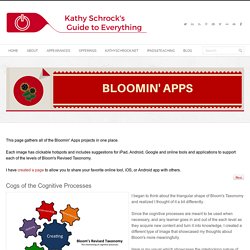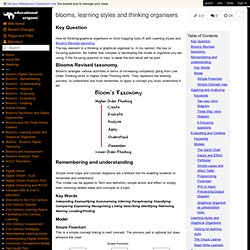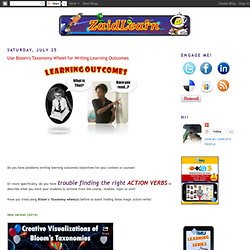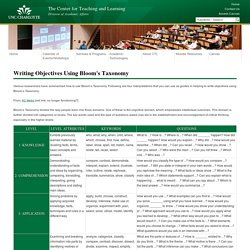

Swfapp/blooms/wheel/engage.swf. Bloom's Taxonomy Presented Visually. Kathy Schrock's Guide to Everything - Bloomin' Apps. This page gathers all of the Bloomin' Apps projects in one place.Each image has clickable hotspots and includes suggestions for iPad, Android, Google and online tools and applications to support each of the levels of Bloom's Revised Taxonomy.I have created a page to allow you to share your favorite online tool, iOS, or Android app with others.

Cogs of the Cognitive Processes I began to think about the triangular shape of Bloom's Taxonomy and realized I thought of it a bit differently.Since the cognitive processes are meant to be used when necessary, and any learner goes in and out of the each level as they acquire new content and turn it into knowledge, I created a different type of image that showcased my thoughts about Bloom's more meaningfully.Here is my visual which showcases the interlocking nature of the cognitive processes or, simply, the "Cogs of the Cognitive Processes". IPAD APPS TO SUPPORT BLOOM'S REVISED TAXONOMYassembled by Kathy Schrock Bloom's and SAMR: My thoughts. Blooms, learning styles and thinking organisers. How do thinking/graphical organisers or mind mapping tools fit with Learning styles and Bloom's Revised taxonomy.

The key element to a thinking or graphical organiser is, in my opinion, the key or focusing question. No matter how complex or developing the model or organiser you are using, if the focusing question or topic is weak the end result will be poor. Bloom's arranges various activities in terms of increasing complexity going from Low Order Thinking skills to Higher Order Thinking skills. They represent the learning process, to understand one must remember, to apply a concept you must understand it etc Simple mind maps and concept diagrams are a brilliant tool for enabling students to remember and understand. Key Words Interpreting Exemplifying Summarising Inferring Paraphrasing Classifying Comparing ExplainingRecognising Listing Describing Identifying Retrieving Naming Locating/Finding Model Simple Flowchart This is a simple concept linking to next concept.
Simple Concept map Models. Use Bloom's Taxonomy Wheel for Writing Learning Outcomes. Why not print out the one you like most (not too many, due to the shortage of trees today!)

, or download the Bloom's Taxonomy wheel images above, and then use them to find those magic action verbs that you might have struggled to find before. These wheels work much better than idiotic tables of action verbs according to Bloom's taxonomy. Trust me! Also, please learn how to apply Bloom's taxonomy to web 2.0 learning tools (and 21st Century learning):Bloom's Digital Taxonomy "It's not about the tools, it's using the tools to facilitate learning. "Finally, here are a few sites worth exploring to learn more about the Bloom's taxonomy (if needed): REFLECTION I still remember when I started off as an Instructional Designer in 2001, I was required to assist subject matter experts (SME) in constructing learning objectives/outcomes. When developing content with SMEs it certainly helps having relevant and agreed upon learning outcomes early on to guide the content development process.
Writing Objectives Using Bloom's Taxonomy. Various researchers have summarized how to use Bloom’s Taxonomy.

Following are four interpretations that you can use as guides in helping to write objectives using Bloom’s Taxonomy. From: KC Metro [old link, no longer functioning?] Bloom’s Taxonomy divides the way people learn into three domains. One of these is the cognitive domain, which emphasizes intellectual outcomes. This domain is further divided into categories or levels. From: UMUC From: Stewards Task Oriented Question Construction Wheel Based on Bloom’s Taxonomy Task Oriented Question Construction Wheel Based on Bloom’s Taxonomy. ©2001 St.
From: GA Tech According to Benjamin Bloom, and his colleagues, there are six levels of cognition: Ideally, each of these levels should be covered in each course and, thus, at least one objective should be written for each level. Below are examples of objectives written for each level of Bloom’s Taxonomy and activities and assessment tools based on those objectives.